Java is one of the most popular programming languages in the world, known for its simplicity, object-oriented structure, and platform independence. At the heart of Java’s object-oriented nature are Classes and Objects , which are essential building blocks in every Java program. Whether you’re a beginner trying to understand the fundamentals or an experienced developer looking to refresh your knowledge, understanding Java Classes and Objects is key to mastering the language.
In this blog post, we’ll dive deep into the concepts of Java Classes and Objects, explain their importance, and provide clear examples to help you get started. By the end, you’ll have a solid understanding of how Java’s object-oriented approach works, enabling you to write more efficient and scalable code.
What are Java Classes?
A Java class is essentially a blueprint or template for creating objects. It defines the properties and behaviors that the objects created from the class will have. In Java, a class contains fields (also known as attributes or variables) and methods (functions that define the behavior of the class).
Here’s a simple example of a Java class:
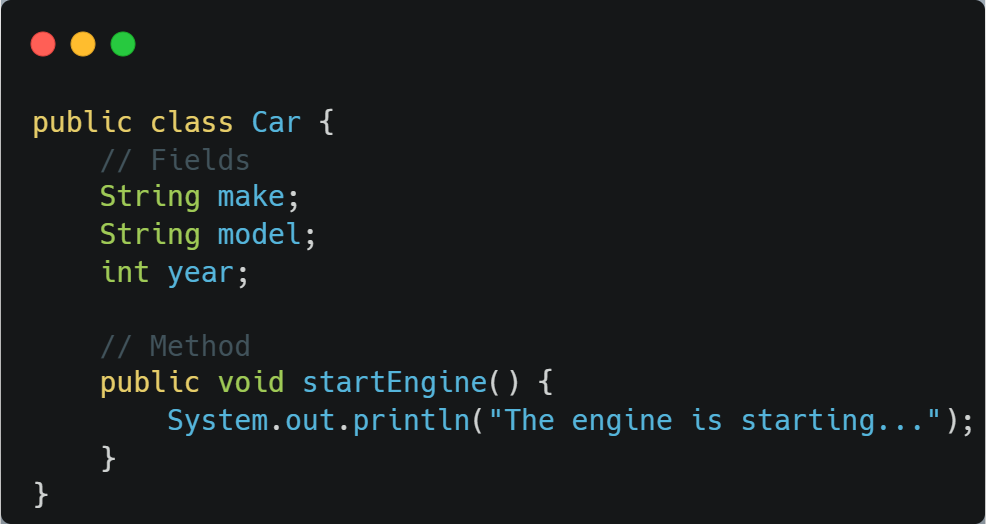
In this example:
- The
Carclass has three fields:make,model, andyear. - It has a method
startEngine()that prints a message when called.
Key Characteristics of a Java Class
- Encapsulation: Classes help in bundling data (fields) and methods (functions) that operate on the data into a single unit.
- Reusability: Once a class is defined, it can be used to create multiple objects without redefining the same logic.
- Modularity: Classes enable breaking down a complex problem into smaller, manageable pieces.
Syntax of a Java Class
The syntax of a Java class is simple and follows a specific structure:
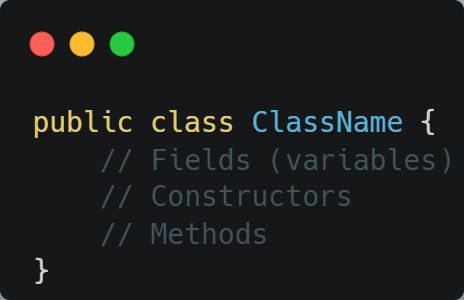
public: This is an access modifier that makes the class accessible from outside the package.class: This keyword is used to define a class.ClassName: The name of the class. By convention, it starts with an uppercase letter
What are Java Objects?
Understanding Java Objects
In Java, an object is an instance of a class. When a class is defined, no memory is allocated. However, when an object is created using the new keyword, memory is allocated for the object, and its properties are initialized.
Here’s how we can create an object from the Car class defined earlier:
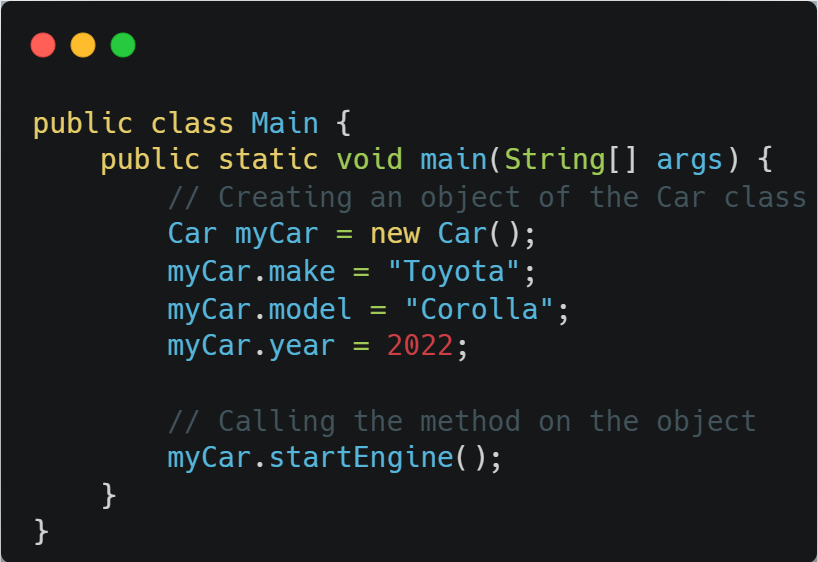
In this example:
myCaris an object of theCarclass.- We set the properties (
make,model,year) and call thestartEngine()method on the object.
Objects vs. Classes
To clarify the difference:
- Class: A class is a blueprint for objects. It defines the structure and behavior of the objects.
- Object: An object is an instance of a class. It holds the actual data and has the ability to invoke methods defined in the class.
Creating and Using Objects in Java

To create an object in Java:
- Use the
newkeyword to allocate memory for the object. - Use the class constructor to initialize the object.
- Access object properties and methods via the object reference.
Constructors in Java
What is a Constructor?
A constructor in Java is a special method that is called when an object is instantiated. It is used to initialize the object with default or provided values.
Here’s a constructor example for the Car class:
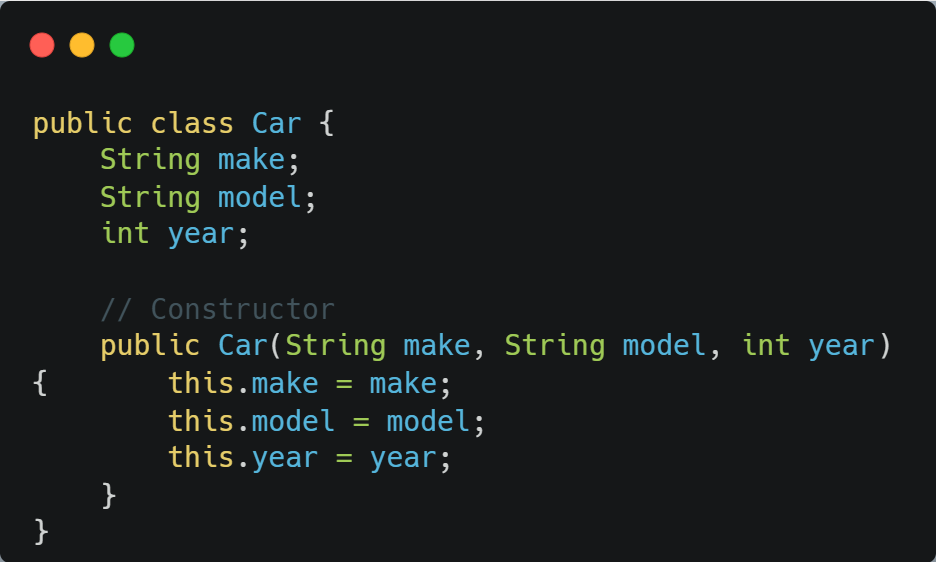
In this case, the constructor initializes the fields of the Car class when an object is created. It ensures that each Car object has a valid make, model, and year value.
Types of Constructors
There are two types of constructors in Java:
- Default Constructor: If no constructor is provided, Java provides a default constructor that initializes the object with default values.
- Parameterized Constructor: A constructor that allows you to pass arguments to initialize the object with specific values.
SEO Title: Understanding Java Classes and Objects: A Comprehensive Guide
Meta Description: Learn about Java Classes and Objects with this comprehensive guide. Discover key concepts, examples, and best practices to master Java programming.
Java Class Methods
Defining and Using Methods in a Class
Methods in Java define the behavior of an object. They can perform actions, return values, and accept parameters.
Here’s an example of a method in the Car class:
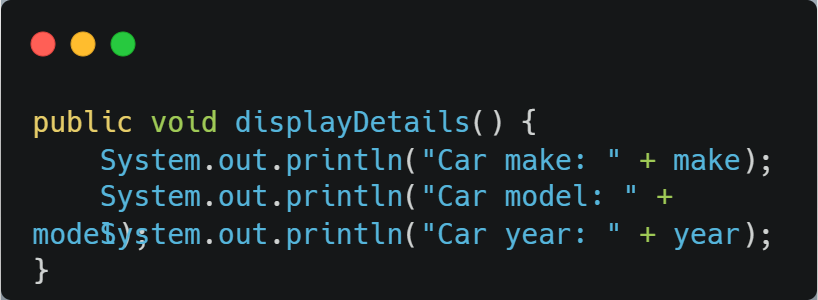
You can call this method on an object of the Car class to display its details.
Method Overloading
In Java, you can create multiple methods with the same name but different parameters. This is called method overloading.

Access Modifiers in Java Classes
Understanding Access Modifiers
Java provides four types of access modifiers that control the visibility of classes, methods, and fields:
- public: Accessible from any other class.
- private: Accessible only within the class where it is defined.
- protected: Accessible within the same package and by subclasses.
- default: If no modifier is specified, it is accessible only within the same package.
Example:

Why Use Access Modifiers?
Access modifiers help in:
- Encapsulation: Restricting access to certain parts of the class.
- Protecting data: Preventing unauthorized access to sensitive data.
- Code clarity: Making the visibility of methods and variables clear.
Best Practices in Using Classes and Objects
Tips for Writing Efficient Java Classes and Objects
- Follow Naming Conventions: Use meaningful and descriptive names for classes and methods.
- Encapsulate Data: Make fields
privateand provide public getter and setter methods to access and modify them. - Use Constructor Overloading: Use constructors to provide flexibility in object initialization.
- Limit the Use of Static Methods: Static methods should be used sparingly as they do not belong to an object.
- Leverage Inheritance and Polymorphism: Use inheritance to create reusable code and polymorphism to write flexible code.
Conclusion
In this guide, we’ve explored the fundamental concepts of Java Classes and Objects. From defining classes and creating objects to understanding constructors and access modifiers, you now have a solid foundation in Java’s object-oriented principles. Remember that mastering these concepts is essential for writing clean, efficient, and scalable Java code.



